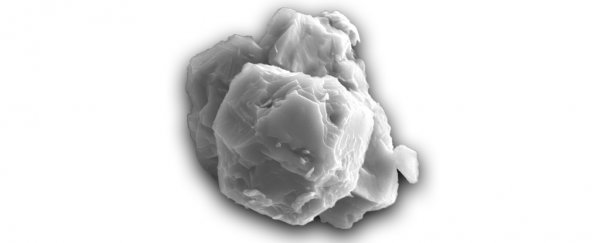The oldest solid material on Earth has just been identified, and it predates the Solar System itself by at least a few hundred million years.
The teensy tiny microscopic grains of dust were forged in a distant star somewhere between 5 and 7 billion years ago, according to new research. By comparison, our Sun is just 4.6 billion years old.
Eventually, these grains were carried to Earth in a meteorite.
"This is one of the most exciting studies I've worked on," said cosmochemist Philipp Heck of the Field Museum of Natural History and the University of Chicago.
"These are the oldest solid materials ever found, and they tell us about how stars formed in our galaxy."
While it's actually not unheard of for meteorites to contain grains of material that predate the Solar System - they're called "presolar grains" - they are rare, and difficult to identify because the bits of material are so small, and deeply embedded in the rock.
One meteorite that is known to contain presolar grains is the Murchison meteorite, a large, over 100 kilogram (220 pound) chunk of space rock that exploded in the sky over Murchison, Australia in September 1969, scattering its fragments all over the place.
The Field Museum acquired 52 kilograms of the Murchison meteorite, and has spent a great deal of time studying it. A large number of microscopic grains of a mineral called silicon carbide from inside the meteorite were identified as interstellar - and therefore presolar - by 1990, but a precise age has been harder to pin down.
A bunch of these silicon carbide grains had already been isolated from the meteorite back in the 1990s, by grinding down the meteorite to powder and dissolving the unwanted silicate with acid. Back then, the tools scientists used to analyse these grains weren't as advanced as they are now, so Heck and his team decided to submit the grains to the full gamut of tests.
They used scanning electron microscopy, secondary ion mass spectrometry and noble gas mass spectrometry, looking for the effects of exposure to cosmic radiation, which can penetrate solid material such as meteorites and leave its mark on the silicon carbide grains.
"Some of these cosmic rays interact with the matter and form new elements. And the longer they get exposed, the more those elements form," Heck explained.
"I compare this with putting out a bucket in a rainstorm. Assuming the rainfall is constant, the amount of water that accumulates in the bucket tells you how long it was exposed."
Forty silicon carbide presolar grains were checked for traces of the particular elements in question - helium-3 and neon-21; these revealed the ages of the grains. A few were quite old, more than 5.5 billion years old, but most of them were younger, between 4.6 and 4.9 billion years old.
This large number of younger grains was unexpected, revealing a surprise about the history of the Milky Way galaxy.
"Our hypothesis is that the majority of those grains, which are 4.9 to 4.6 billion years old, formed in an episode of enhanced star formation," Heck said. "There was a time before the start of the Solar System when more stars formed than normal."
This period of star formation would have been about 7 billion years ago, according to the team's findings. As the stars reached advanced stages of their evolution, the grains would have condensed into outflows and blown out into space, later to be taken up and incorporated into what would become the Murchison meteorite.
Because it's not expected that these grains would survive, for example, supernova shockwaves in isolation, the team infers that they must have stuck together in clumps, which would have shielded some of them.
And, Heck said, the discovery of a furious starburst in microscopic grains wrapped up in a meteorite confirms that star formation ebbs and flows.
"Some people think that the star formation rate of the galaxy is constant," he said.
"But thanks to these grains, we now have direct evidence for a period of enhanced star formation in our galaxy 7 billion years ago with samples from meteorites. This is one of the key findings of our study."
It's just mind-blowing to think of everything those tiny specks must have passed through before landing here on Earth.
The research has been published in PNAS.
